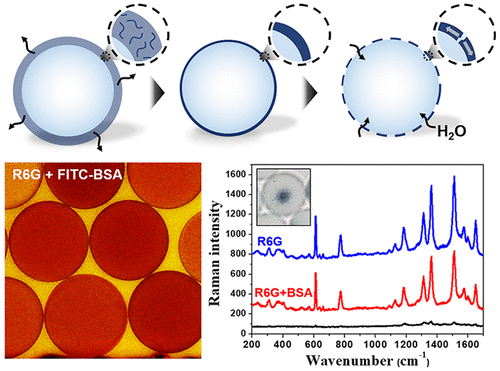当前位置:
X-MOL 学术
›
Chem. Mater.
›
论文详情
Our official English website, www.x-mol.net, welcomes your
feedback! (Note: you will need to create a separate account there.)
Osmotic-Stress-Mediated Control of Membrane Permeability of Polymeric Microcapsules
Chemistry of Materials ( IF 7.2 ) Pub Date : 2018-09-27 00:00:00 , DOI: 10.1021/acs.chemmater.8b03230 Sangmin Lee 1 , Tae Yong Lee 1 , Dong Jae Kim 1 , Bomi Kim 1 , Shin-Hyun Kim 1
Chemistry of Materials ( IF 7.2 ) Pub Date : 2018-09-27 00:00:00 , DOI: 10.1021/acs.chemmater.8b03230 Sangmin Lee 1 , Tae Yong Lee 1 , Dong Jae Kim 1 , Bomi Kim 1 , Shin-Hyun Kim 1
Affiliation

|
Microcapsules with regular pore size can provide size-selective permeation, which is promising for immunoisolation of cells, protection of enzymes or catalysts, and development of capsule-type sensors. However, conventional approaches have limited biocompatibility or poor dispersion stability of encapsulants. Here, we suggest a simple yet pragmatic method to produce semipermeable microcapsules using osmotic stress. With a capillary microfluidic device, monodisperse microcapsules with ultrathin polymer membranes are prepared by double-emulsion templating. The microcapsules are subjected to a hypotonic condition, by which water is pumped in imposing a tensile stress on the membrane. The osmotic stress initiates cracks at weak spots. As cracks propagate, the pressure gradually reduces as ions diffuse through them, finally resulting in a finite width of cracks. The final width can be controlled from 5 to 10 nm using an initial osmotic pressure of 230 to 690 kPa, enabling fine adjustment of the cutoff threshold of permeation. This osmotic-pressure-mediated control is highly compatible with delicate biological molecules and colloidal dispersions as no etching chemicals are required to form pores. Taking advantage of this method, we demonstrate a capsule-type molecular sensor based on surface-enhanced Raman scattering that obviates pretreatment of samples because the membrane allows the entrance of small target molecules while blocking the large adhesive proteins.
中文翻译:

渗透-压力介导的聚合物微囊膜通透性的控制
具有规则孔径的微胶囊可以提供尺寸选择性的渗透,这有望用于细胞的免疫分离,酶或催化剂的保护以及胶囊型传感器的开发。但是,常规方法的生物相容性有限或密封剂的分散稳定性差。在这里,我们建议一种简单而实用的方法来利用渗透压生产半透性微胶囊。使用毛细管微流体装置,通过双乳液模板制备具有超薄聚合物膜的单分散微胶囊。使微胶囊处于低渗状态,通过泵送水以在膜上施加拉伸应力。渗透应力在弱点处引发裂纹。随着裂纹的传播,离子逐渐扩散,压力逐渐降低,最终导致有限的裂缝宽度。使用230至690 kPa的初始渗透压,可以将最终宽度控制在5至10 nm之间,从而可以精确调节渗透的截止阈值。这种渗透压介导的控制与精细的生物分子和胶体分散体高度兼容,因为不需要蚀刻化学品即可形成孔。利用这种方法,我们展示了一种基于表面增强拉曼散射的胶囊型分子传感器,该传感器无需进行样品预处理,因为该膜允许小目标分子进入,同时阻止了大的粘附蛋白。这种渗透压介导的控制与精细的生物分子和胶体分散体高度兼容,因为不需要蚀刻化学品即可形成孔。利用这种方法,我们展示了一种基于表面增强拉曼散射的胶囊型分子传感器,该传感器无需进行样品预处理,因为该膜允许小目标分子进入,同时阻止了大的粘附蛋白。这种渗透压介导的控制与精细的生物分子和胶体分散体高度兼容,因为不需要蚀刻化学品即可形成孔。利用这种方法,我们展示了一种基于表面增强拉曼散射的胶囊型分子传感器,该传感器无需进行样品预处理,因为该膜允许小目标分子进入,同时阻止了大的粘附蛋白。
更新日期:2018-09-27
中文翻译:

渗透-压力介导的聚合物微囊膜通透性的控制
具有规则孔径的微胶囊可以提供尺寸选择性的渗透,这有望用于细胞的免疫分离,酶或催化剂的保护以及胶囊型传感器的开发。但是,常规方法的生物相容性有限或密封剂的分散稳定性差。在这里,我们建议一种简单而实用的方法来利用渗透压生产半透性微胶囊。使用毛细管微流体装置,通过双乳液模板制备具有超薄聚合物膜的单分散微胶囊。使微胶囊处于低渗状态,通过泵送水以在膜上施加拉伸应力。渗透应力在弱点处引发裂纹。随着裂纹的传播,离子逐渐扩散,压力逐渐降低,最终导致有限的裂缝宽度。使用230至690 kPa的初始渗透压,可以将最终宽度控制在5至10 nm之间,从而可以精确调节渗透的截止阈值。这种渗透压介导的控制与精细的生物分子和胶体分散体高度兼容,因为不需要蚀刻化学品即可形成孔。利用这种方法,我们展示了一种基于表面增强拉曼散射的胶囊型分子传感器,该传感器无需进行样品预处理,因为该膜允许小目标分子进入,同时阻止了大的粘附蛋白。这种渗透压介导的控制与精细的生物分子和胶体分散体高度兼容,因为不需要蚀刻化学品即可形成孔。利用这种方法,我们展示了一种基于表面增强拉曼散射的胶囊型分子传感器,该传感器无需进行样品预处理,因为该膜允许小目标分子进入,同时阻止了大的粘附蛋白。这种渗透压介导的控制与精细的生物分子和胶体分散体高度兼容,因为不需要蚀刻化学品即可形成孔。利用这种方法,我们展示了一种基于表面增强拉曼散射的胶囊型分子传感器,该传感器无需进行样品预处理,因为该膜允许小目标分子进入,同时阻止了大的粘附蛋白。











































 京公网安备 11010802027423号
京公网安备 11010802027423号